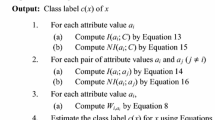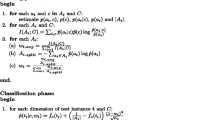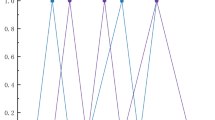Abstract
There are two central parts in multiple attribute decision making (MADM), which are weight assignment and attribute selection. However, attribute selection is usually ignored in the existing researches, which will result in the difficulty of knowledge acquisition and the error of decision making. In addition, with respect to the data set with labels, the existing methods of weight assignment usually neglect or do not take full advantage of the supervisory function of labels, which may also lead to some decision making mistakes. To make up for these deficiencies, this paper proposes a method for knowledge acquisition and decision making based on Bayes risk minimization. In this method, a novel Bayes risk model based on neighborhood and Gaussian kernel is raised, and a heuristic forward greedy algorithm is designed for attribute selection. Finally, a number of experiments, including the comparison experiments on University of California Irvine (UCI) data and the effectiveness evaluation of fighter, are carried out to illustrate the superiority and applicability of the proposed method.













Similar content being viewed by others
Notes
http://weka.wikispaces.com, v3.6.13
δ = 0.05 in NGBR.
References
Amaldi E, Kann V (1998) On the approximability of minimizing nonzero variables or unsatisfied relations in linear systems. Theor Comput Sci 209(1-2):237–260
Bongers A, Torres JL (2014) Technological change in US jet fighter aircraft. Res Policy 43(9):1570–1581
Chandrashekar G, Sahin F (2014) A survey on feature selection methods. Comput Electr Eng 40(1):16–28
Chen YW, Lin CJ (2005) Combining svms with various feature selection strategies. Studies in Fuzziness & Soft Computing 207:315–324
Deng H, Yeh CH, Willis RJ (2000) Inter-company comparison using modified topsis with objective weights. Comput Oper Res 27(10):963–973
Diakoulaki D, Mavrotas G, Papayannakis L (1995) Determining objective weights in multiple criteria problems: The critic method. Comput Oper Res 22(7):763–770
Duda RO, Hart PE, Stork DG (2001) Pattern Classification, 2nd. Wiley, New York
Fei DY, An X (2006) Synthesized index model for fighter plane air combat effectiveness assessment. Acta Aeronautica Et Astronautica Sinica 27(6):1084–1087
Goel V, Kumar S, Byrne W (2002) Segmental minimum bayes-risk asr voting strategies. pp 334–344
Gonzlez-Rubio J, Casacuberta F (2015) Minimum bayes AF risk subsequence combination for machine translation. Pattern Anal Applic 18(3):523–533
Gu Q, Li Z, Han J (2011) Generalized fisher score for feature selection. In: 27th conference on uncertainty in artificial intelligence, pp 266–273
He Y, Guo H, Jin M, Ren P (2016) A linguistic entropy weight method and its application in linguistic multi-attribute group decision making. Nonlinear Dyn 84(1):1–6
Hu L, Gao W, Zhao K, Zhang P, Wang F (2018) Feature selection considering two types of feature relevancy and feature interdependency. Expert Syst Appl 93:423–434
Hu Q, Yu D, Liu J, Wu C (2008) Neighborhood rough set based heterogeneous feature subset selection. Inf Sci 178(18):3577–3594
IT J (1986) Principle component analysis. Springer, New York
Jiang F, Sui Y (2015) A novel approach for discretization of continuous attributes in rough set theory. Knowl-Based Syst 73(1):324–334
Kira K, Rendell LA (1992) A practical approach to feature selection. In: International workshop on machine learning, pp 249–256
Kononenko I (1994) Estimating attributes: Analysis and extensions of relief. In: European conference on machine learning on machine learning, pp 171–182
Kumar S, Byrne W (2002) Minimum bayes-risk word alignments of bilingual texts. In: Acl-02 conference on empirical methods in natural language processing, pp 140–147
Liu J, Lin Y, Lin M, Wu S, Zhang J (2017) Feature selection based on quality of information. Neurocomputing 225:11–22
Liu S, Li H (2016) A Human Factors Integrated Methods for Weapon System Effectiveness Evaluation. Springer, Singapore
Ma F, He J, Ma J, Xia S (2017) Evaluation of urban green transportation planning based on central point triangle whiten weight function and entropy-ahp. Transportation Research Procedia 25:3638–3648
Peng H, Long F, Ding C (2005) Feature selection based on mutual information criteria of max-dependency, max-relevance, and min-redundancy. IEEE Transactions on Pattern Analysis & Machine Intelligence 27(8):1226–1238
Saeys Y, Inza I, Larrañaga P (2007) A review of feature selection techniques in bioinformatics. Bioinforma 23(19):2507–2517
Song QJ, Jiang HY, Liu J (2017) Feature selection based on fda and f-score for multi-class classification. Expert Syst Appl 81:22–27
Valkenhoef GV, Tervonen T (2016) Entropy-optimal weight constraint elicitation with additive multi-attribute utility models. Omega 64:1–12
Wang L, Zhang H, Xu H (2008) Multi-index synthesize evaluation model based on rough set theory for air combat efficiency. Acta Aeronautica Et Astronautica Sinica 29(4):880–885
Wang L, Shen J, Mei X (2017) Cost sensitive multi-class fuzzy decision-theoretic rough set based fault diagnosis. In: Chinese control conference, pp 6957–6961
Wang YM, Luo Y (2010) Integration of correlations with standard deviations for determining attribute weights in multiple attribute decision making. Math Comput Model 51(1-2):1–12
Yang GL, Yang JB, Xu DL, Khoveyni M (2016) A three-stage hybrid approach for weight assignment in madm. Omega 71:93–105
Yao Y (2004) A partition model of granular computing. In: LNCS transactions on rough sets, pp 232–253
Zhu B, Zhu R, Xiong X (1993) Fighter plane effectiveness assessment. Aviation Industry Press, Beijing
Zhu XZ, Zhu W, Fan XN (2017) Rough set methods in feature selection via submodular function. Soft Comput 21(13):3699–3711
Acknowledgements
Thanks to all anonymous reviewers for their guidance and comments to this paper. This study is supported by the Fundamental Research Funds for the Central Universities (Grant No. HIT.KLOF.2017.074).
Author information
Authors and Affiliations
Corresponding authors
Rights and permissions
About this article
Cite this article
Suo, M., Zhang, Z., Chen, Y. et al. Knowledge acquisition and decision making based on Bayes risk minimization method. Appl Intell 49, 804–818 (2019). https://doi.org/10.1007/s10489-018-1272-5
Published:
Issue Date:
DOI: https://doi.org/10.1007/s10489-018-1272-5




